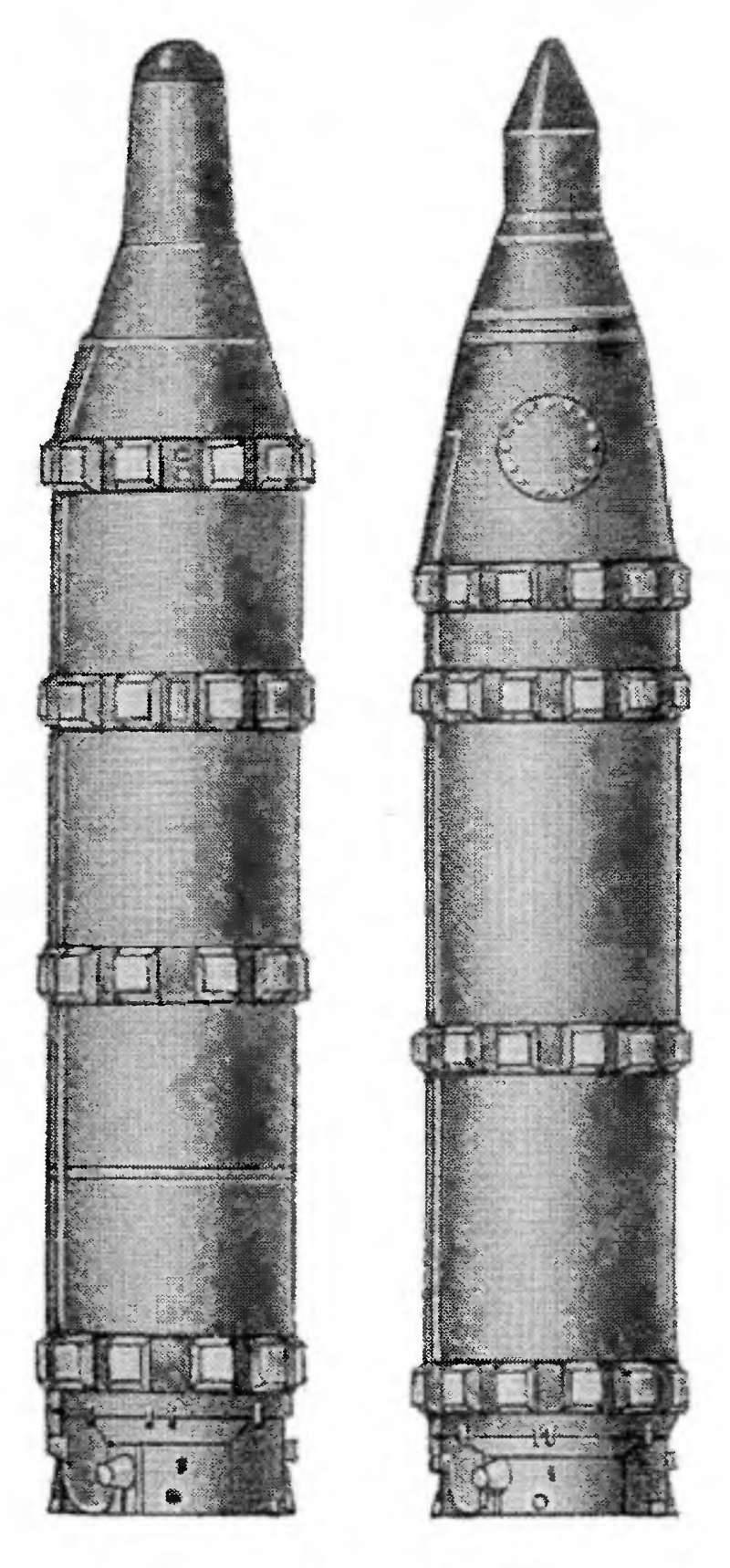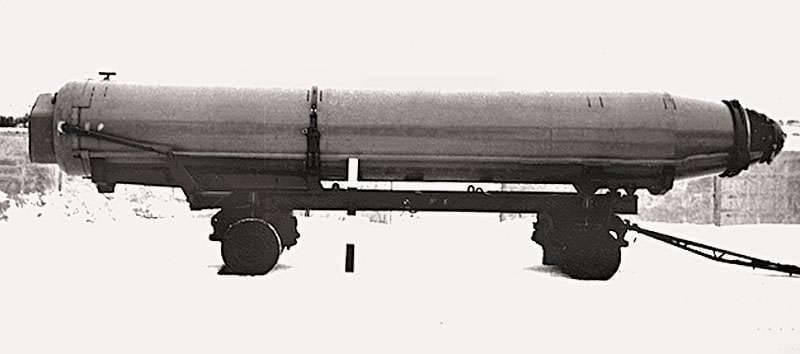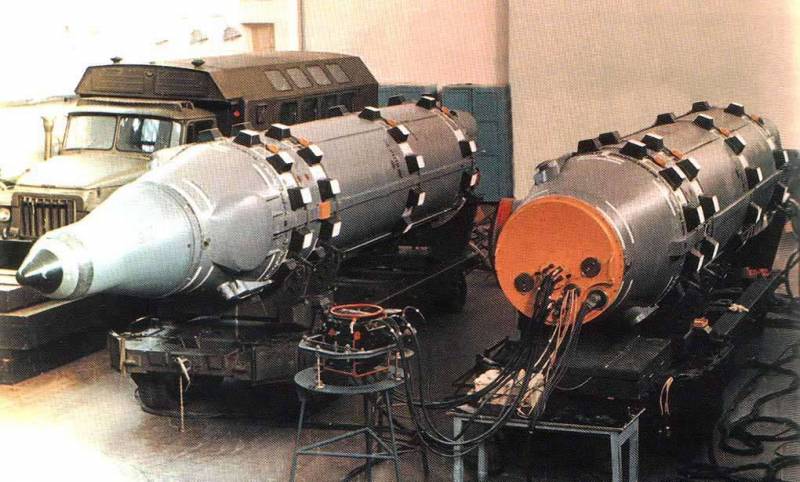Soviet anti-ship ballistic missile projects
The idea of a ballistic missile, designed to defeat large surface ships, was formed by the end of the fifties. By that time, the likely adversaries of our country had managed to build numerous and powerful fleets, which should be fought at distant approaches. Cruise missiles for long-range bombers and submarines already existed, but their flight range did not meet current requirements. Both the carrier aircraft and the submarine would be forced to enter the defense zone of the enemy’s ship group.
The obvious way out of this situation was to see ballistic missiles of submarines. With its small size and weight, the product of this class could fly to a distance of several thousand kilometers. Because of this, the possibility of attacking a naval compound from a safe area appeared. By the beginning of the sixties, the formation of a new concept was completed, which made it possible to move from research to experimental design work.
Projects D-5T and D-5J
The first participant in the development of a ballistic missile development program for submarines was the Leningrad TsKB-7 (now the Arsenal Design Bureau named after MV Frunze), headed by P.A. Tyurin. Since 1958, this organization has been developing the D-6 complex with a fundamentally new solid-fuel rocket. The study of the issue showed that such a rocket can be taken as a basis for promising anti-ship missiles with fairly high characteristics. As a result, a project started with a working designation D-5T.
The base missile complex D-6 was a two-stage product with solid-fuel engines. At each stage it was proposed to use four independent engines in separate hulls. In addition, on the head fairing provided for starting engines designed to exit the launcher. The elaboration of a new project has shown that the D-5T rocket will be able to fly a distance up to 1500-2000 km. The increase in range in comparison with the base sample was achieved by reducing the mass of the head part.
At the beginning of 1961, the Miass SKB-385 (now SRC named after VP Makeyev) joined the work on the new theme. His project, which received the working designation D-5J, provided for the creation of a completely new rocket with a liquid power plant. Such a rocket could send a special warhead to a range of 1800 km.
The diesel-electric and nuclear submarines of several projects were to become carriers of the D-6 complex. As a carrier of the D-5T system, only a specialized modification of the 661 project was considered. The issue of creating such a submarine was worked out in TsKB-16 (now the Malakhit SPMBM). Later, after the appearance of the D-5Ж project, a proposal appeared to adapt the two complexes to use on the modified submarines of the 667 project. However, the development of such a project took time, which led to the emergence of an unusual proposal. SKB-385 was instructed to work out a version of the ballistic missile for basing on special surface ships.
Further development of the two projects led to the abandonment of a solid-fuel rocket. It was found that the D-5Zh complex will be more convenient to use, and therefore this project should be developed. Further development of the new project was carried out under the designation D-5. Finally, another important decision was made. A promising weapon of submarines was to be a rocket of a new modification, initially worked out in the framework of the ship armament project.
Complex D-5 with rocket R-27K
In April 1962, the USSR Council of Ministers decided to start developing a new anti-ship missile system for submarines. The complex as a whole was designated as D-5, the rocket for it was Р-27К or 4К18. As follows from the designation, the new anti-ship missile was supposed to be a special modification of the existing medium-range missile of the P-27 type.
Within a few months, SKB-385 has shaped the look of the new complex and determined the range of necessary modifications to the existing rocket. It was proposed to use a two-stage rocket, in which the first stage was responsible for bringing the second to a given trajectory. The second stage, respectively, was to carry the means of homing and the warhead. Since it was about the defeat of moving targets, the rocket had to bear the means of detection and homing.
At the same time, it was found that the development of PKR is faced with a number of difficulties. Thus, the guidance and control tools with the required characteristics turned out to be too large. Because of this, the second stage could take up to 40% of the allowed dimensions of the product. In addition, the homing head had to be closed with a radiotransparent heat resisting fairing. Suitable materials at that time in our country were absent.
Existing difficulties led to the appearance of two preliminary projects. They used a common first stage, based on the units of the P-27 rocket, and the second stages were developed from scratch. The first stage differed from the basic design with a shortened hull with tanks of reduced capacity. 4D10 engine, controls, etc. remained the same. Two versions of the second stage, differing in equipment and the principles of work, received designations "A" and "B".
Both projects suggested the use of passive radar homing head with a side-view antenna. Up to a given moment, the folded antenna had to be inside the case, and then go out and fold out. This provided a search for signals from the electronic systems of the enemy ship, which could determine its location and adjust the course of the rocket.
Project A offered a relatively complex management system. On the ascending part of the trajectory, the rocket had to correct the trajectory with the help of special second-stage engines. When moving down to the target, it was necessary to use the aerodynamic control surfaces and adjust the course according to the head antenna receiving signals from the front hemisphere. In the project “B” it was proposed to use the course correction only until reaching the descending part of the trajectory. The first version of the means of guidance was much more difficult, and also increased the dimensions of the second stage, but it could give a higher accuracy of hitting the target.
The variant of the second stage with the letter “B” was adopted for further development. Thus, the 4K18 / P-27K rocket had to search for a target using a passive seeker with a side-view antenna. The need for a head antenna disappeared. For the further development of electronics, the scientific research institute-592 (now NPO Avtomatiki) was involved in the project. With it, an improved GOS with a more efficient antenna was created.
The product P-27K, according to the project, had a length of 9 m with a diameter of 1,5 m. Starting weight - 13,25 t. From the base P-27 it externally differed in an elongated head fairing of a more complex shape. The second stage carried a special warhead with a power of 650 kt, able to compensate for some decrease in accuracy. The refusal of a full-fledged power plant at the second stage and the reduction of the fuel stock in the first led to a reduction in the flight range. Thus, the base missile P-27 flew on 2500 km, while the new 4K18 flew only on 900 km.
It should be noted that the work on the P-27 and P-27K projects was associated with certain difficulties. As a result, the base ballistic missile entered service only in the 1968 year, and the CRP tests were started only two years later. The first test launch of 4K18 / P-27K was performed at the Kapustin Yar testing ground in December 1970 of the year.
Using ground-based launchers, 20 test runs were performed, of which the entire 4 was crashed. Further several throwing launches from the sinking stand took place. After that, work began on preparing the missile system for testing on a submarine carrier.
It should be noted that since the mid-sixties, the D-5 project has encountered certain difficulties in the search for media. Some submarines did not meet the technical requirements, while others could not be used with anti-ship missiles, since they had to carry strategic missiles. As a result, they decided to make a diesel-electric boat K-102 of 629 project an experienced carrier of the complex. In accordance with the new project “605”, it was to receive four launch shafts and a set of various equipment for working with missiles.
9 December 1972, the K-102 submarine launched the P-27K for the first time. Tests lasted about a year, and during this time used 11 experienced missiles. 3 November 1973-th pair launching of missiles on the target barge. One product 4K18 hit the target exactly, while the second made a slight miss. It is important that at the time of the launch of the missiles, the uncertainty of the target's position reached 75 km. Despite this, the rockets independently found the target and pointed at it.
Despite the successful completion of the tests, in early September 1975, the D-5 / R-27K project was closed. The passive radar seeker could not give the required reliability of solving problems, and counteraction to it was not difficult. The nuclear warhead, in turn, made it difficult to deploy submarines with new anti-ship missiles due to new international agreements. Finally, serious progress has already been made in the field of cruise missiles. In such a situation, the existing D-5 complex was not of interest to fleet.
The D-13 complex with the P-33 rocket
Shortly after the launch of the P-27K rocket tests, in the middle of 1971, SKB-385 received a new task. Now he was required to create a D-13 complex with an anti-ship ballistic missile R-33. The latter was to be based on the design of the P-29 product and hit targets at ranges up to 2000 km using a monoblock or split warhead.
The development of the P-33 rocket was carried out using the basic ideas and concepts of the previous P-27K project. Thus, the base P-29 was planned to be “shortened” to two steps, but at the same time to be assembled from ready-made components. The first stage, as before, was to be responsible for the acceleration of the rocket, and the second stage was supposed to mount a warhead and means of guidance. Due to the presence of special equipment, the second stage was quite large and heavy. Despite this, the rocket as a whole had to meet the limitations of existing launchers.

Comparison of missiles P-27 and P-27K (left). The picture "Weapons of the domestic fleet. 1945-2000"
To increase the firing range associated with an increase in the target detection distance, an improved homing head was required. It was distinguished by its large size, and this led to a reduction in the dimensions of the first stage in favor of the second. The reduction of the first-stage tanks could lead to a reduction in the flight range to 1200 km. There were also serious problems with the operating conditions of the systems. A new type of homing head needed a radio-transparent radome capable of withstanding high temperatures during descent. In this case, a plasma cloud could form, at a minimum, hindering the work of electronic systems.
And yet, in 1974, SKB-385 managed to solve part of the problems and submit an advance design of the D-13 missile system. The first stage of the rocket, unified with the P-29, was equipped with tanks for heptyl and nitrogen tetroxide, and also carried the 4-X75 engine. The second stage did not have a full-fledged power plant and was equipped only with engines for maneuvering. It also housed a passive radar homing head with a pair of antennas, controls, and a special warhead. Due to the improvement of the systems, accompanied by a decrease in their dimensions, it was possible to increase the fuel supply and bring the firing range to 1800 km.
According to the preliminary design, the P-33 rocket had a length of 13 m with a diameter of 1,8 m. The launch mass at the time of design changed several times from 26 to 35 t. The 667B boats were considered as a carrier of such missiles. To use a new type of anti-ship missiles, they had to receive equipment for receiving target designation and control of the missile during prelaunch.
According to the plans of the seventies, soon the project was to be considered by specialists of the military department. The beginning of the tests was planned for the end of the seventies, and by the middle of the next decade the D-13 complex could be put into service.
However, this did not happen. The customer analyzed the existing project and decided to abandon it. At the beginning of September, two projects were stopped at once by one order at once: D-1975 / Р-5К and D-27 / Р-13. The reasons for the rejection of the two complexes were the same. They did not show the desired technical characteristics, the actual combat effectiveness was limited by the characteristic problems of the means of guidance, and the presence of a nuclear warhead imposed restrictions on deployment.
Ground-based ICBM
As is known, the UR-100 intercontinental ballistic missile was initially considered as a means for solving various combat missions in different conditions. Among other things, the modification of such a rocket was developed for placement on submarines. According to some data, the possibility of using the modified UR-100 as an anti-ship weapon was also considered.

The P-29 rocket, on the basis of which the P-33 product was created. Photos Otvaga2004.ru
According to reports, that from a certain time in OKB-52 under the direction of V.N. Chelomey dealt with the question of the existing ICBM for special tasks. By substantially reworking the design, the UR-100 product could become an anti-ship missile, characterized by the highest range and special power of the warhead. However, as far as is known, this project, along with a number of others, remained at the stage of preliminary study. The full-fledged project was not developed, and experienced PKR based on the UR-100 were not tested.
However, it is known that in the middle of 1970, two launches of the experimental UR-100 missiles, equipped with radar homing heads, took place. It is possible that these tests were directly related to the elaboration of the creation of a promising anti-ship missile of medium intercontinental range.
Some sources mention the idea of creating an anti-ship missile based on the "land" ICBM complex "Topol". However, in this case, the ideas were not implemented. Moreover, there is every reason to believe that such a project or proposal never existed and in fact it is only a matter of rumors.
***
As of the end of the fifties, the Soviet Union was faced with certain problems in the fight against the ship’s factions of a potential enemy. Existing weapons capable of sinking large ships had limited characteristics and forced submariners or sailors to take risks. In such conditions, promising ballistic anti-ship missiles could become a promising means of fighting the enemy.
For several years, Soviet industry has developed a number of projects of this kind. Two anti-ship anti-ship missile projects reached the stage of full-fledged design work, and one of them was even brought to the test. Interesting results were obtained during the D-5 and D-13 projects, but their practical perspectives were mixed. The presence of a number of technical difficulties and limited combat capabilities did not allow to fully realize the full potential of the new weapon.
In addition, success in other areas was adversely affected. By the time the design of the R-27K rocket was completed, new models appeared aviation equipment, as well as cruise missiles for aviation, ships and submarines. Modern weapons of this kind surpassed ballistic anti-ship missiles in a number of parameters and made them unnecessary. As a result, such weapons were abandoned in our country. After 1975, when the military decided to close the D-5 and D-13 projects, we did not develop new systems of this kind.
Based on:
http://makeyev.ru/
http://alternathistory.com/
http://rbase.new-factoria.ru/
http://nvo.ng.ru/
http://deepstorm.ru/
http://otvaga2004.ru/
http://defence.ru/
http://bastion-karpenko.ru/
Shirokorad A.B. Weapons of the domestic fleet. 1945-2000. Minsk: Harvest, 2001.



Information